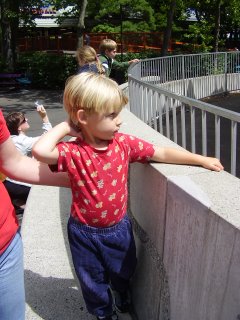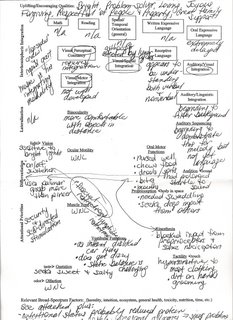Little Frog's evaluation began with a two and one-half hour observation. Judith and Kate (a second Handle therapist) had reviewed the pre-evaluation paperwork I sent in. Judith met us at the door to the building and allowed Little Frog to follow his bliss as he explored the new surroundings, running up and down the halls, into and out of various offices, storage rooms and the staff breakroom. Throughout the observation she spoke to him as a reasonable, rational individual and only asked us questions about him after telling him her plan to do so and waiting for his reaction. We knew little frog had receptive language skills even though he would fail any school test for them. He can not usually show you he heard you and understood you by following a direction. He gives other, more subtle clues. It was obvious that he figured out right away that Judith also knew he could understand her and he seemed to appreciate it. His clues were much less subtle with her than usual. She also pointed out, when she or we began talking and little frog up and left the room, he was still listening. In fact, she observed he seemed to have less trouble with auditory discrimination from a distance. (we already knew he had less trouble with visual processing from a distance). He demonstrated this by returning to the room ready to participate in the activity we had just been discussing. She also did not make a lot of demands for little frog to do things. He has a great deal of trouble with motor planning, especially when the objective is not an idea from his own mind. This makes most evaluations pointless - he is not going to put the puzzle together or stack the blocks or color on the paper when requested to do so. Judith spent most of the observation period observing. She provided some different stimuli (noise from toys, objects with different textures, red and blue lensed paper glasses) and watched how he responded. She also spent a great deal of time noting his postures, gate, eye movement, hand positions, and looking at his feet and hands (providing some pressure to different reflexology points with little frog's permission.)
During the course of the observation she asked us some rather startling questions about any problems little frog had with heart murmur, testes, and allergies. All of these are issues for little frog. None of these were mentioned in the paperwork I provided. She said she sensed these were problems from the way he protected certain parts of his foot when he walked and certain hand positions he maintained. She put her hand into the position his was in and felt a pulling across her chest near her heart. (on a side note - Toe Walking protects the heal area, associated with the organs of the digestive track, from extra pressure. Do you know anyone who has intestinal and gut issues who walks on their toes?) I tried this technique the following morning when little frog kept protruding his lower jaw and tensing his face for no apparent reason. When I tried it, my sinuses exploded. Little frog had been very stuffy when he woke up that morning.

At the end of the observation, we were excused for a two hour lunch break while Judith and Kate reviewed the tape, their notes and our paperwork. As it was little frog's birthday, we went to the Seattle Center. He did really well. He sat in a chair in the Center House for a good 20 min. while Mommy and Daddy had a quick lunch (he had a giant cookie, having eatten his during the evaluation). We went to the "Fun Forest" and after watching for a little while, little frog had his first Merry-go-round ride followed by the, aptly named, frog bouncer and then the flying elephant. All smiles and giggles - no melt downs, no biting or scratching, no running away. A very successful outing :0) We followed the rides with a quick car nap then went back to HANDLE for the results of the eval.
Judith spent another two hours going over her observations and findings. She provided us with a program of simple exercises that, if done one after another, could be accomplished in about 30 min. a day. She also talked to little frog about protein and what it does for the body and brain and what types of foods would be good sources of protein; the idea of blowing on his arm when he got frustrated or felt like biting it; and what each exercise was designed to do and how it might help. Here is the matrix she designed for little frog. It shows his strengths and weaknesses and how they interconnect. How his blocked input from proprioceptors, nocioceptors, and the fascia resulted in more mouthing and biting to get sensory input. How fascial and lymphatic restrictions impacted his vestibular system and in turn his ability to differentiate sounds. She also noted the lack of visual perceptual, visual spacial, visual motor and auditory intergration. Some of this mirrors what we have learned from occupational and speech therapy. The difference here is we have something we can do to work on strengthening the underlying weak systems that should allow the occupational and speech therapy to work better. Here is the matrix Judith arrived at for little frog. Click on the image to make it bigger. I'll talk about the exercises in the next post:

No comments:
Post a Comment